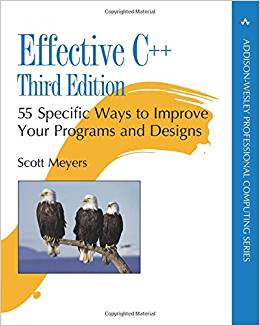C++学习书籍推荐《Effective C++ 第三版(英文)》下载

百度云及其他网盘下载地址:点我
作者简介
Scott Meyers is one of the world's foremost authorities on C++, providing training and consulting services to clients worldwide. He is the author of the best-selling Effective C++ series of books (Effective C++, More Effective C++, and Effective STL) and of the innovative Effective C++ CD. He is consulting editor for Addison Wesley's Effective Software Development Series and is a founding member of the Advisory Board for The C++ Source (http://www.artima.com/cppsource). He holds a Ph.D. in Computer Science from Brown University. His web site is http://www.aristeia.com.
目录
Preface xv
Acknowledgments xvii
Introduction 1
Chapter 1: Accustoming Yourself to C++ 11
Item 1: View C++ as a federation of languages. 11
Item 2: Prefer consts, enums, and inlines to #defines. 13
Item 3: Use const whenever possible. 17
Item 4: Make sure that objects are initialized before they’re used. 26
Chapter 2: Constructors, Destructors, and Assignment Operators 34
Item 5: Know what functions C++ silently writes and calls. 34
Item 6: Explicitly disallow the use of compiler-generated functions you do not want. 37
Item 7: Declare destructors virtual in polymorphic base classes. 40
Item 8: Prevent exceptions from leaving destructors. 44
Item 9: Never call virtual functions during construction or destruction. 48
Item 10: Have assignment operators return a reference to *this. 52
Item 11: Handle assignment to self in operator=. 53
Item 12: Copy all parts of an object. 57
Chapter 3: Resource Management 61
Item 13: Use objects to manage resources. 61
Item 14: Think carefully about copying behavior in resource-managing classes. 66
Item 15: Provide access to raw resources in resource-managing classes. 69
Item 16: Use the same form in corresponding uses of new and delete. 73
Item 17: Store newed objects in smart pointers in standalone statements. 75
Chapter 4: Designs and Declarations 78
Item 18: Make interfaces easy to use correctly and hard to use incorrectly. 78
Item 19: Treat class design as type design. 84
Item 20: Prefer pass-by-reference-to-const to pass-by-value. 86
Item 21: Don’t try to return a reference when you must return an object. 90
Item 22: Declare data members private. 94
Item 23: Prefer non-member non-friend functions to member functions. 98
Item 24: Declare non-member functions when type conversions should apply to all parameters. 102
Item 25: Consider support for a non-throwing swap. 106
Chapter 5: Implementations 113
Item 26: Postpone variable definitions as long as possible. 113
Item 27: Minimize casting. 116
Item 28: Avoid returning “handles” to object internals. 123
Item 29: Strive for exception-safe code. 127
Item 30: Understand the ins and outs of inlining. 134
Item 31: Minimize compilation dependencies between files. 140
Chapter 6: Inheritance and Object-Oriented Design 149
Item 32: Make sure public inheritance models “is-a.” 150
Item 33: Avoid hiding inherited names. 156
Item 34: Differentiate between inheritance of interface and inheritance of implementation. 161
Item 35: Consider alternatives to virtual functions. 169
Item 36: Never redefine an inherited non-virtual function. 178
Item 37: Never redefine a function’s inherited default parameter value. 180
Item 38: Model “has-a” or “is-implemented-in-terms-of” through composition. 184
Item 39: Use private inheritance judiciously. 187
Item 40: Use multiple inheritance judiciously. 192
Chapter 7: Templates and Generic Programming 199
Item 41: Understand implicit interfaces and compile-time polymorphism. 199
Item 42: Understand the two meanings of typename. 203
Item 43: Know how to access names in templatized base classes. 207
Item 44: Factor parameter-independent code out of templates. 212
Item 45: Use member function templates to accept “all compatible types.” 218
Item 46: Define non-member functions inside templates when type conversions are desired. 222
Item 47: Use traits classes for information about types. 226
Item 48: Be aware of template metaprogramming. 233
Chapter 8: Customizing new and delete 239
Item 49: Understand the behavior of the new-handler. 240
Item 50: Understand when it makes sense to replace new and delete. 247
Item 51: Adhere to convention when writing new and delete. 252
Item 52: Write placement delete if you write placement new. 256
Chapter 9: Miscellany 262
Item 53: Pay attention to compiler warnings. 262
Item 54: Familiarize yourself with the standard library, including TR1. 263
Item 55: Familiarize yourself with Boost. 269
Appendix A: Beyond Effective C++ 273
Appendix B: Item Mappings Between Second and Third Editions 277
Index 280
百度云及其他网盘下载地址:点我
C++学习书籍推荐《Effective C++ 第三版(英文)》下载的更多相关文章
- C语言学习书籍推荐《C Primer Plus(中文版)(第5版)》下载
普拉塔 (Prata S.) (作者), 云巅工作室 (译者) <C Primer Plus(中文版)(第5版)>共17章,介绍了C语言的基础知识,包括数据类型.格式化输入输出.运算符.表 ...
- java虚拟机的学习书籍推荐
javaEE开发已然是一个老生常谈的话题了,但经典之所以会成为经典,就是因为有可重复琢磨之处,每一次的反复推敲都会有不一样的收获.如果你不满足于做一个只会写if…else…的Java程序员,而是希望更 ...
- C++学习书籍推荐《Accelerated C++中文版》下载
百度云及其他网盘下载地址:点我 媒体推荐 书评 这是一本一流的C++入门书,它采用了一种和实践相结合的方式来解决具体的问题.相比我所见过的其他C++入门书来说,本书以令人惊奇的紧凑格式覆盖了更多的关于 ...
- C语言学习书籍推荐《C陷阱与缺陷》下载
下载地址:点我 凯尼格 (作者), 高巍 (译者) <C和C++经典著作:C陷阱与缺陷>适合有一定经验的C程序员阅读学习,即便你是C编程高手,<C和C++经典著作:C陷阱与缺陷> ...
- C语言学习书籍推荐《C和指针 Pointers On C》下载
<C和指针 POINTERS ON C>提供与C语言编程相关的全面资源和深入讨论.本书通过对指针的基础知识和高 级特性的探讨,帮助程序员把指针的强大功能融入到自己的程序中去. 全书共18 ...
- java学习书籍推荐
1. Java 语言基础 谈到Java 语言基础学习的书籍,大家肯定会推荐Bruce Eckel 的<Thinking in Java >.它是一本写的相当深刻的技术书籍,Java 语言基 ...
- linux学习书籍推荐linux学习书籍推荐
引用地址:http://www.cnblogs.com/notepi/archive/2013/06/15/3137103.html Linux 学习书目推荐 Linux基础 1.<Linux与 ...
- 19年最新 Python0基础学习书籍推荐(内涵PDF地址以及书籍源码)
去年看过一篇文章,是关于18年的最适合0基础学习的书籍,今年,最新的书籍也已经统计出来.书籍的PDF太过于难找,所以很多PDF都找不到. 仅仅只能找到英文版PDF 本文章统计了18.19并做过对比,在 ...
- c++学习书籍推荐《C++沉思录》下载
百度云及其他网盘下载地址:点我 编辑推荐 经典C++图书,应广大读者的强烈要求再版 目录 第0章 序幕第一篇 动机第1章 为什么我用C++第2章 为什么用C++工作第3章 生活在现实世界中 第二篇 类 ...
- c++学习书籍推荐《C++编程思想第一卷》下载
百度云及其他网盘下载地址:点我 编辑推荐 <C++编程思想>(第1卷)(第2版)第1版荣获"软件开发"杂志评选的1996年度 图书震撼大奖,中文版自2000年推出以来, ...
随机推荐
- MVC WebApi的两种访问方法
//UserInfoController using ClassLibrary; using System;using System.Collections.Generic;using System. ...
- 快速写入Xml文件
我们在做一些操作的时候会需要生成日志,Xml文件就是我们常用的一种日志文件. 普通操作Xml文件的代码遇到大数据量的话就很慢了. 用这个生成Xml文件的话,即使数据量很大,也很快 private vo ...
- 深入理解SQL Server 2005 中的 COLUMNS_UPDATED函数
原文:深入理解SQL Server 2005 中的 COLUMNS_UPDATED函数 概述 COLUMNS_UPDATED函数能够出现在INSERT或UPDATE触发器中AS关键字后的任何位置,用来 ...
- 《Microsoft编写优质无错C程序秘诀》提纲
第1章 假想的编译程序1.使用编译程序所有的可选警告设施2.使用lint来查出编译程序漏掉的错误3.如果有单元测试,就进行单元测试第2章 自己设计并使用断言1.既要维护程序的交付版本,又要维护程序的调 ...
- 通过异步程序调用(APC)实现的定时功能
定时器是一个在特定时间或者规则间隔被激发的内核对象.结合定时器的异步程序调用可以允许回调函数在任何定时器被激发的时候执行.本文的例子代码显示了如何实现. 使用本定时器时,你需要把常量_WIN32_WI ...
- ef 查询总结
1.Linq 查询两张表:a表和b表,要得到的数据是a表数据b表没有 例如:a表有5条数据1,2,3,4,5:b表有2条数据1,3:那么就用dataGridView1输出2,4,5:link语句要怎么 ...
- Elasticsearch教程(二)java集成Elasticsearch
1.添加maven <!--tika抽取文件内容 --> <dependency> <groupId>org.apache.tika</groupId> ...
- Qt https 用户认证authenticationRequired()
用QNetworkAccessManager以POST方式访问https需要用户认证,所以用SIGNAL(authenticationRequired(QNetworkReply *, QAuthen ...
- GetParent、SetParent、MoveWindow - 获取、指定父窗口和移动窗口,IsChild - 判断两个窗口是不是父子关系
提示: SetParent 应该 Windows.SetParent, 因为 TForm 的父类有同名方法. //声明: {获取父窗口句柄} GetParent(hWnd: HWND): HWND; ...
- delphi 在多线程中使用 CreateOleObject 导致失败(一定要使用CoInitialize和CoUninitialize,举例查询WMI)
原帖地址 http://bbs.csdn.net/topics/390481350 解决办法 procedure DisplayVideoInfo; var wmi, objs, obj : OleV ...
